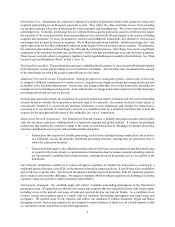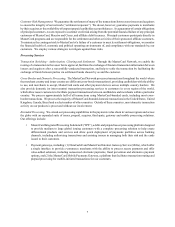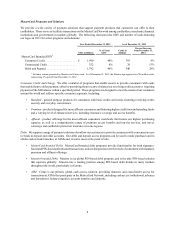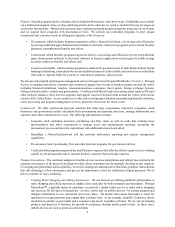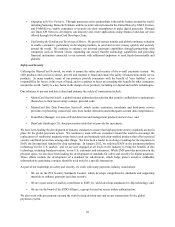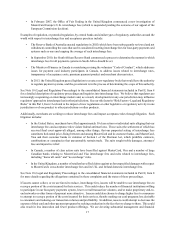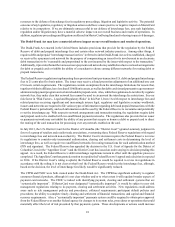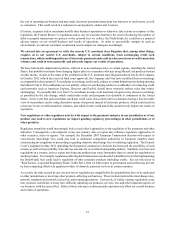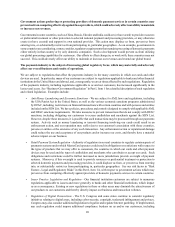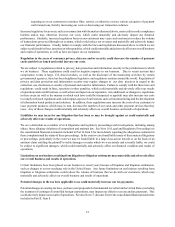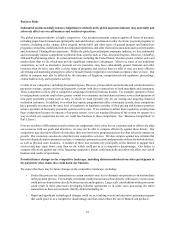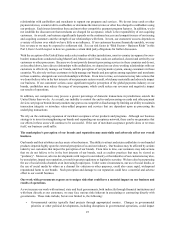MasterCard 2013 Annual Report Download - page 20
Download and view the complete annual report
Please find page 20 of the 2013 MasterCard annual report below. You can navigate through the pages in the report by either clicking on the pages listed below, or by using the keyword search tool below to find specific information within the annual report.16
Website and SEC Reports
The Company's internet address is www.mastercard.com. From time to time, we may use our website as a channel of
distribution of material company information. Financial and other material information is routinely posted and
accessible on the investor relations section of our corporate website. In addition, you may automatically receive e-
mail alerts and other information about MasterCard by enrolling your e-mail address by visiting “E-Mail Alerts” in the
investor relations section of our corporate website.
Our annual report on Form 10-K, quarterly reports on Form 10-Q, current reports on Form 8-K and amendments to
those reports are available, without charge, for review on the investor relations section of our corporate website as soon
as reasonably practicable after they are filed with, or furnished to, the U.S. Securities and Exchange Commission. The
information contained on our website is not incorporated by reference into this Report.
Item 1A. Risk Factors
Legal and Regulatory Risks
Interchange fees and acceptance practices receive significant and intense legal, regulatory and legislative scrutiny
worldwide, and the resulting decisions, regulations and legislation may have a material adverse impact on our
overall business and results of operations.
Interchange fees are generally the largest component of the costs that acquirers charge merchants in connection with
the acceptance of payment cards. They are also a factor on which we compete with other payment providers and
therefore an important determinant of the volume of transactions we process over our network. We do not earn revenues
from interchange fees. We have historically set default interchange fees in the United States and certain other countries.
In some jurisdictions, interchange fees and related practices are subject to legislation, regulation and litigation as
electronic forms of payment have become more important to local economies. Regulators and legislative bodies in a
number of countries, as well as merchants, are seeking to reduce these fees through legislation, competition-related
regulatory proceedings, central bank regulation and/or litigation.
Examples of legislative activity related to interchange fees include:
• In July 2013, the European Commission proposed legislation relating to payment system regulation of cards
issued and acquired within the European Economic Area (the “EEA”). The proposed legislation includes,
among other things, the following elements: (1) a cap on credit and debit interchange fees of 30 and 20 basis
points per transaction, respectively, initially for intra-EEA cross-border consumer transactions (these cross-
border rates are comparable to the consumer rates MasterCard has applied for Europe on a weighted average
basis since July 2009), and subsequently for all domestic consumer transactions in the EEA; (2) restrictions
on our “honor all cards” rule with respect to products with different levels of interchange; (3) a prohibition of
surcharging by merchants for products that are subject to regulated interchange rates; (4) the prohibition of
rules that prevent an issuer from “co-badging” (that is, putting a competing brand on its credit or debit cards);
and (5) the separation of brand and processing in terms of legal form, organization and decision making.
Procedurally, the proposed legislation is currently being debated, and may be potentially amended, by the
European Union Parliament. The proposed legislation will also need to be reviewed by the Council of Ministers
and the European Commission before it can be adopted. Any final legislation, if approved by the European
Union Parliament and the Council of Ministers, could be different than what is in the initial proposal.
• In Poland and Hungary, legislation became effective in January 2014 capping domestic interchange fees, and
similar legislation is being considered in other jurisdictions such as Portugal and Israel.
Examples of competition-related regulatory proceedings or inquiries around the world with respect to interchange fees
and acceptance practices include:
• In December 2007, the European Commission issued a negative decision (upheld by a judgment of the General
Court of the European Union, which we are appealing) with respect to our cross-border interchange fees for
consumer credit and debit cards under European Union competition rules.


